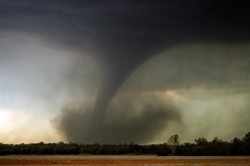Tornadoes

Tornadoes
The most violent tornadoes are capable of tremendous destruction with wind speeds of 400 kilometres per hour or more. Damage paths can be in excess of a kilometre wide and 80 kilometres long. When a tornado is coming, you only have a short amount of time to make decisions, so be prepared.
What Should I Do Before a Tornado?
- Make sure that you review your Family Emergency Plan with your family and that everyone knows what they should do.
- Make sure that your Emergency Survival Kit is fully stocked and that your family knows where it is. Be prepared to be self-sufficient for several days, in the event of widespread power outages or disruption of public utilities.
- Establish a safe zone in your home and place of work (preferably in the basement or in a small interior room or hallway) and make sure that everyone knows where to go.
- Have an AM/FM Radio in your house that everyone knows how to use. Make sure that your radio is battery-operable and that you have a fresh supply of batteries on hand.
- Monitor weather forecasts before you go on a trip or spend an extended period of time outdoors.
- Learn tornado warning signs. Although tornadoes vary greatly in their appearance and can offer little or no warning, it can be helpful to be aware of signs that a tornado could be imminent:
- A dark, often greenish sky.
- A wall cloud, particularly if it is rotating.
- Large hail. Although not always, storms that produce tornadoes frequently produce large hail as well.
- A loud roar, similar to the sound of a freight train.
- Tornadoes may occur near the trailing edge of a thunderstorm and be quite visible. They may also be embedded in rain and not be visible at all.
What Should I Do During a Tornado Watch?
- Listen to your local radio or television stations for updated information.
- Be alert to rapidly-changing weather conditions. Watch for signs of a possible tornado.
- Know where your family members are. Use this opportunity to review your Family Emergency Plan. Even if a tornado does not strike, there is still a likelihood of severe weather conditions.
During a Tornado - Listen to your local radio or television stations for updated information. If the electricity should go out, you will still be able to receive emergency information on a battery-operated device.
- If you're at home, go to your pre-identified safe zone to protect yourself from glass and other flying objects. If possible, seek shelter under a piece of large, sturdy furniture, such as a large table or workbench to protect yourself from falling debris or flying objects. Stay away from windows. Do NOT open them.
- If a basement is not available, move to a small interior room or hallway on the lowest floor and get under a sturdy piece of furniture. Put as many walls as possible between you and the outside.
- Do not open windows: use the time to seek shelter.
- Use arms to protect head and neck.
- Remain in your safe zone or shelter until you have received an all-clear signal from your radio.
- If you're not in your home, seek shelter in the basement or an interior room of a nearby, sturdy building. Do not try to outrun a tornado in your car; instead, leave it immediately. If no shelter is available, lie flat in a low spot with your arms and hands protecting your head. Contrary to popular belief, seeking shelter underneath a highway or railroad overpass does not provide any measurable safety.
- Be aware of flying debris, as it causes the most injuries and fatalities during a tornado.
- Mobile homes offer little protection from tornadoes. You should leave a mobile home and go to the lowest floor of a sturdy nearby building or storm shelter.
What Should I Do After a Tornado?
- Continue listening to your local radio or television stations for updated information.
- Review your Family Emergency Plan and follow through with your communications plan. If all of your family members are not present, report to your family's pre-designated meeting point, unless emergency officials direct otherwise.
- Assess any damage to your home or immediate surroundings. Be aware of any potential hazards (ruptured gas lines, structural damage to your home, downed electrical lines, localized flooding, etc.) Immediately report any injuries or hazards via 911. Advise your family and neighbours as well.
- Help injured or trapped persons. Call 911. Give first aid where appropriate. Do not move seriously injured persons unless they are in immediate danger. Never enter any building that appears to have suffered significant structural damage, or that poses any other hazards.
- Do not enter any disaster area. Your presence there will simply add to the confusion and may hamper emergency response efforts. A public message will be sent in the event that volunteers are needed.
- Only use the telephone for emergency calls. Once you have notified your pre-identified emergency contact person that you are okay, let them notify other family or loved ones. Telephones are frequently overwhelmed in a disaster situation and need to be clear for emergency calls to get through.
